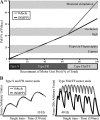Inhibition of TrkB kinase activity impairs transdiaphragmatic pressure generation
- PMID: 31944892
- PMCID: PMC7052584
- DOI: 10.1152/japplphysiol.00564.2019
Inhibition of TrkB kinase activity impairs transdiaphragmatic pressure generation
Abstract
Signaling via the tropomyosin-related kinase receptor subtype B (TrkB) regulates neuromuscular transmission, and inhibition of TrkB kinase activity by 1NMPP1 in TrkBF616A mice worsens neuromuscular transmission failure (NMTF). We hypothesized that acute inhibition of TrkB kinase activity will impair the ability of the diaphragm muscle to produce maximal transdiaphragmatic pressure (Pdi) without impacting the ability to generate forces associated with ventilation, consistent with the greater susceptibility to NMTF in motor units responsible for higher-force nonventilatory behaviors. Adult male and female TrkBF616A mice were injected with 1NMPP1 (n = 8) or vehicle (DMSO; n = 8) 1 h before Pdi measurements during eupneic breathing, hypoxia/hypercapnia (10% O2/5% CO2), tracheal occlusion, spontaneous deep breaths ("sighs") and during maximal activation elicited by bilateral phrenic nerve stimulation. In the vehicle-treated group, Pdi increased from ~10 cmH2O during eupnea and hypoxia/hypercapnia, to ~35 cmH2O during sighs and tracheal occlusion, and to ~65 cm H2O during maximal stimulation. There was no effect of acute 1NMPP1 treatment on Pdi generated during most behaviors, except during maximal stimulation (~30% reduction; P < 0.05). This reduction in maximal Pdi is generally similar to the worsening of NMTF previously reported with TrkB kinase inhibition in rodents. Accordingly, impaired TrkB signaling limits the range of motor behaviors accomplished by the diaphragm muscle and may contribute to neuromuscular dysfunction, primarily by impacting fatigable, higher force-generating motor units.NEW & NOTEWORTHY TrkB signaling plays an important role in maintaining neuromuscular function in the diaphragm muscle and may be necessary to accomplish the various motor behaviors ranging from ventilation to expulsive, behaviors requiring near-maximal forces. This study shows that inhibition of TrkB kinase activity impairs maximal pressure generation by the diaphragm muscle, but the ability to generate the lower pressures required for ventilatory behaviors is not impacted.
Keywords: diaphragm muscle; motor unit; neuromuscular junction; neuromuscular transmission; neurotrophins.
Conflict of interest statement
No conflicts of interest, financial or otherwise, are declared by the authors.
Figures



Similar articles
-
Chloroquine impairs maximal transdiaphragmatic pressure generation in old mice.J Appl Physiol (1985). 2023 Nov 1;135(5):1126-1134. doi: 10.1152/japplphysiol.00365.2023. Epub 2023 Oct 12. J Appl Physiol (1985). 2023. PMID: 37823202 Free PMC article.
-
TrkB signaling contributes to transdiaphragmatic pressure generation in aged mice.J Neurophysiol. 2021 Apr 1;125(4):1157-1163. doi: 10.1152/jn.00004.2021. Epub 2021 Feb 17. J Neurophysiol. 2021. PMID: 33596726 Free PMC article.
-
TrkB kinase activity maintains synaptic function and structural integrity at adult neuromuscular junctions.J Appl Physiol (1985). 2014 Oct 15;117(8):910-20. doi: 10.1152/japplphysiol.01386.2013. Epub 2014 Aug 28. J Appl Physiol (1985). 2014. PMID: 25170066 Free PMC article.
-
Phrenic motor unit recruitment during ventilatory and non-ventilatory behaviors.Respir Physiol Neurobiol. 2011 Oct 15;179(1):57-63. doi: 10.1016/j.resp.2011.06.028. Epub 2011 Jul 6. Respir Physiol Neurobiol. 2011. PMID: 21763470 Free PMC article. Review.
-
Functional recovery after cervical spinal cord injury: Role of neurotrophin and glutamatergic signaling in phrenic motoneurons.Respir Physiol Neurobiol. 2016 Jun;226:128-36. doi: 10.1016/j.resp.2015.10.009. Epub 2015 Oct 23. Respir Physiol Neurobiol. 2016. PMID: 26506253 Free PMC article. Review.
Cited by
-
Electrical epidural stimulation of the cervical spinal cord: implications for spinal respiratory neuroplasticity after spinal cord injury.J Neurophysiol. 2021 Aug 1;126(2):607-626. doi: 10.1152/jn.00625.2020. Epub 2021 Jul 7. J Neurophysiol. 2021. PMID: 34232771 Free PMC article. Review.
-
Diaphragm muscle function in a mouse model of early-onset spasticity.J Appl Physiol (1985). 2022 Jul 1;133(1):60-68. doi: 10.1152/japplphysiol.00157.2022. Epub 2022 May 19. J Appl Physiol (1985). 2022. PMID: 35608200 Free PMC article.
-
Chloroquine impairs maximal transdiaphragmatic pressure generation in old mice.J Appl Physiol (1985). 2023 Nov 1;135(5):1126-1134. doi: 10.1152/japplphysiol.00365.2023. Epub 2023 Oct 12. J Appl Physiol (1985). 2023. PMID: 37823202 Free PMC article.
-
Age-related impairment of autophagy in cervical motor neurons.Exp Gerontol. 2021 Feb;144:111193. doi: 10.1016/j.exger.2020.111193. Epub 2020 Dec 5. Exp Gerontol. 2021. PMID: 33290859 Free PMC article.
-
Brain derived neurotrophic factor/tropomyosin related kinase B signaling impacts diaphragm neuromuscular transmission in a novel rat chemogenetic model.Front Cell Neurosci. 2022 Oct 28;16:1025463. doi: 10.3389/fncel.2022.1025463. eCollection 2022. Front Cell Neurosci. 2022. PMID: 36385943 Free PMC article.
References
-
- Ermilov LG, Pulido JN, Atchison FW, Zhan WZ, Ereth MH, Sieck GC, Mantilla CB. Impairment of diaphragm muscle force and neuromuscular transmission after normothermic cardiopulmonary bypass: effect of low-dose inhaled CO. Am J Physiol Regul Integr Comp Physiol 298: R784–R789, 2010. doi:10.1152/ajpregu.00737.2009. - DOI - PMC - PubMed
Publication types
MeSH terms
Substances
Grants and funding
LinkOut - more resources
Full Text Sources

